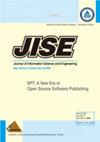Selection of Embedding Area: A Better Way to Use Prediction-Error Expansion Method for Reversible Hiding
IF 1.1
4区 计算机科学
Q4 COMPUTER SCIENCE, INFORMATION SYSTEMS
Journal of Information Science and Engineering
Pub Date : 2020-05-01
DOI:10.6688/JISE.202005_36(3).0009
引用次数: 1
Abstract
Reversible data hiding is widely used because the host image can be recovered without errors after the extraction of hidden data. One of the popular schemes for reversibility involves the use of prediction-error expansion (PEE). Scholars often modify the basic PEE scheme to hide more secret bits or to improve the quality in stego images. Examples include the pairwise PEE, the difference expansion approach , and others. In our PEE-based method here, by identifying which parts of a prediction error histogram indicate inefficient hiding, we propose increasing the ratio of pixels hiding data to the pixels shifted without hiding data, called the efficiency ratio (ER). We used four tests to improve ER and hence improve the quality of stego images. The basic concept of our method is to check whether an image block or pixel is suitable for embedding data. After deleting the blocks or pixels that are likely to yield erroneous predictions, we can reduce the chance of a high PE. A high PE not only deteriorates the quality of stego images, but also contributes nothing to the embedding capacity. As shown in experiments, our image quality is better than that of many other PEEbased algorithms when similar amounts of data are hidden.嵌入区域的选择:一种利用预测误差展开法进行可逆隐藏的更好方法
由于提取隐藏数据后可以准确无误地恢复主机图像,因此可逆数据隐藏技术得到了广泛的应用。一种流行的可逆性方案涉及使用预测误差展开(PEE)。学者们经常修改基本的PEE方案来隐藏更多的秘密位或提高隐写图像的质量。示例包括成对的PEE、差异展开方法等。在我们基于pee的方法中,通过识别预测误差直方图的哪些部分表示低效隐藏,我们建议增加隐藏数据的像素与不隐藏数据的移位像素的比率,称为效率比(ER)。我们使用了四种测试来提高ER,从而提高隐写图像的质量。我们方法的基本概念是检查图像块或像素是否适合嵌入数据。在删除可能产生错误预测的块或像素后,我们可以减少高PE的机会。高PE不仅会降低隐写图像的质量,而且对嵌入容量没有任何贡献。实验表明,当隐藏相似数量的数据时,我们的图像质量优于许多其他基于pee的算法。
本文章由计算机程序翻译,如有差异,请以英文原文为准。
求助全文
约1分钟内获得全文
求助全文
来源期刊

Journal of Information Science and Engineering
工程技术-计算机:信息系统
CiteScore
2.00
自引率
0.00%
发文量
4
审稿时长
8 months
期刊介绍:
The Journal of Information Science and Engineering is dedicated to the dissemination of information on computer science, computer engineering, and computer systems. This journal encourages articles on original research in the areas of computer hardware, software, man-machine interface, theory and applications. tutorial papers in the above-mentioned areas, and state-of-the-art papers on various aspects of computer systems and applications.
 求助内容:
求助内容: 应助结果提醒方式:
应助结果提醒方式:


